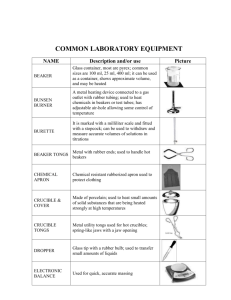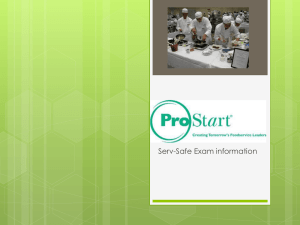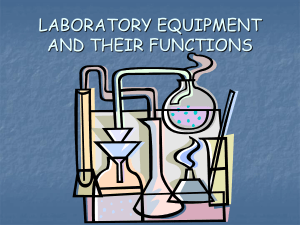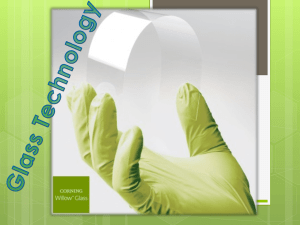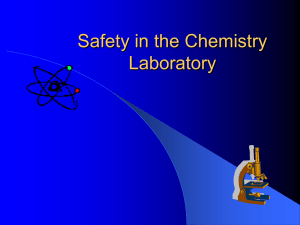Familiarization With Apparatus_Equipment_StudentCopy
advertisement
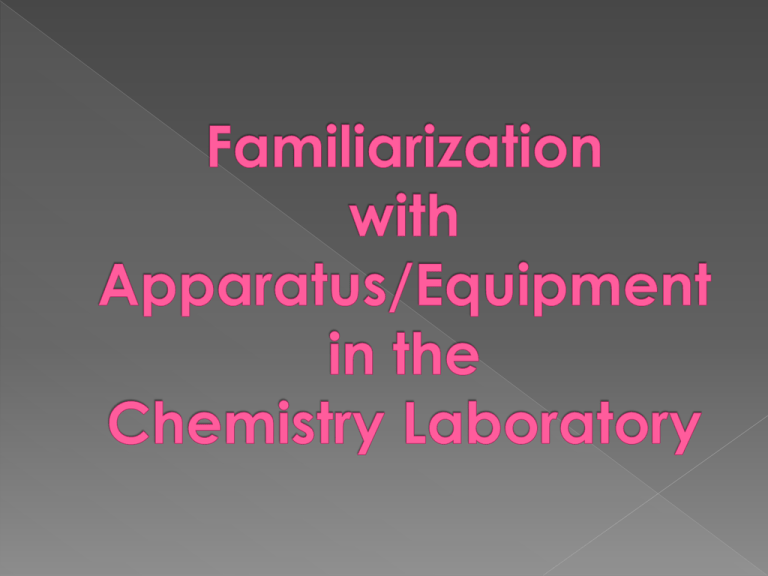
As containers For measuring mass For measuring volume For support As guide for flow As source of heat For picking-up Objects In Other Ways No lab would be complete without a Beaker. It’s a Multipurpose and essential in the lab. Description: The flat bottom and spout allow this piece of glassware to be stable on the lab bench or hot plate, plus it's easy to pour a liquid without making a mess. Beakers are also easy to clean. Most beakers are made from borosilicate glass Function/Use: reaction container holds liquid or solid samples to catch liquids from titrations and filtrates from filtering operations for mixing to heat liquids Test Tube Description: round-bottom cylinders usually made of borosilicate glass so that they can withstand temperature changes and resist reaction with chemicals. several sizes sometimes called culture tubes (a test tube without a lip). Function/Use: for holding small samples or mixtures (liquid, solid and gas) for containing small-scale reactions. Erlenmeyer Flask is one of the most common and useful pieces of chemistry lab glassware. Description: flat-bottomed, cone-shaped flask (stable on table) usually made of borosilicate glass (can be heated over a flame or autoclaved) most common sizes: 250 mL & 500 mL Function/Use: to measure large volume mix and store chemicals used to heat liquids (wide bottom allows faster heating because of the greater surface area exposed to the heat) also used to catch filtrates. Florence Flask (also called boiling flask) Description: round-bottom borosilicate glass container with thick walls, capable of withstanding temperature changes. Function/Use: used for heating subtances that need to be heated evenly bulbed-bottom allows the heat to distribute through the liquid more evenly mostly used in distillation experiments. Description: long, thin neck with a line for measuring a specified volume usually have flat bottoms usually made of borosilicate glass typical sizes: 25, 50, 100, 250, 500, 1000 mL Function/Use: to measure one specific volume of liquid to make precise dilutions mostly used in mixing solutions where a one liter or one half a liter is needed Volumetric Flasks Petri dishes come as a set. Description: flat bottom dish and a flat lid that rests loosely over the bottom made from a borosilicate glass, such as Pyrex or Kimax plastic petri dishes also are available Function/Use: commonly are used for culturing bacteria in a microbiology lab, containing small living specimens, and holding chemical samples. Description: Glass bottles with ground glass stoppers some are made of plastic Function/Use: to store stock solutions of chemicals for mixing for displaying. Description: concave dishes that have a variety of uses cannot resist high temperature. It should never be heated. Function/Use: for holding small samples for observation under a low-power microscope As lids flasks, beakers or evaporating dishes. for evaporating liquid off of samples, such as growing seed crystals hold solids when being weighed or transported Description: round bottom flask the end of the neck of the flask is typically a conical ground glass joint. Erlenmeyer Bulb Function/Use: often used when even heating or boiling of a sample is needed. Description: cup-shaped piece of laboratory glassware they come with lids Crucible (with cover) Function/Use: used to hold small amount of solid substance which are to be heated to high temperatures Description: wide porcelain dish highly resistant to high temperatures Evaporating Dish Function/Use: used to hold small amount of substance that needs heating in order to evaporate liquids. Description: Made of plastic (can be squeezed) has narrow tube from bottom (inside) that extends out of the bottle (pointed tip) to dispense as squeezed Function/Use: for dispensing small quantities of distilled water. to rinse off chemical substances from containers especially in qualitative analysis Wash Bottles Description: Has a metal pan on the left With three sliders on the three beams Triple Beam Balance Function/Use: to measure masses very precisely (the reading error is 0.05 gram Analytical Balance Description: an electronic scale has a weighing pan inside a glass case has adjustable feet, level indicator , on/off switch, LCD Display , zero switch, mode switch and tare switch Function/Use: measures mass of an object to an accuracy of ± 0.0001 grams (0.1 mg precision) Graduated Cylinder Description: usually are made from borosilicate glass Common sizes are 10, 25, 50, 100, 250, 500, 1000 mL Function/Use: used to measure volumes accurately to the nearest 0.1 mL can be used to calculate the density of an object if its mass is known Beaker measures large volumes up to an accuracy within 10% Erlenmeyer Flask measures large volumes up to an accuracy within 10% Volumetric Flask measures one specific volume with high precision Description: a graduated tube of glassware that has a stopcock at its bottom end Function/Use: used to dispense precise volumes of liquid reagents. used in titrations to measure precisely how much liquid is used. used for addition of a precise volume of liquid to the nearest 0.01 mL used for chemical calculations based on the volume measured Buret (or Burette) Pipets (Pipettes) Description: are droppers calibrated to deliver a specific volume There are many different types of pipets: disposable, reusable, autoclavable, and manual. may be made of glass or plastic. This type of pipet is marked like graduated cylinders. Function/Use: to measure and transfer small volumes. Pipets (Pipettes) Description: has a line to mark a specific volume precise apparatus Volumetric Pipets Function/Use: this type of pipet is filled to a line to reliably deliver one volume again and again. to measure and transfer a specific volume. Test tube Rack Description: Made of wood or plastic have slots for test tubes to stand upright or inverted Function/Use: to hold test tubes while reactions happen in them or while they are not needed. Wire Gauze Description: wire mesh with a fireproof sheet (circle) in the middle to spread flame Stiff-meshed wire woven together Function/Use: used on a ring to support beakers to be heated by Bunsen burners used to spread heat of a burner flame Clay Triangle Description: a wire frame with a triangular shape with hollow porcelain cylinders on the 3 sides Function/Use: are placed on a ring attached to a ring stand as a support for a funnel, crucible, or evaporating dish. Tripod Description: A three-legged apparatus with a circular top frame made of metal Function/Use: used as a support for the vessel to be heated Description: made of iron or steel An iron stand is a long metal rod with a flat rectangular base. an iron ring is a metal ring attached to a stand by a screw. Function/Use: iron stand supports the iron ring when heating substances or mixtures in a flask or beaker (using a Bunsen burner) clamps can also be used to hold glasswares on the iron ring Iron Stand with Iron Ring Iron Stand Description: made of iron or steel a long metal rod with a flat rectangular base. Function/Use: Ring stand with clamps (such as buret clamps) are for holding pieces of glassware in place. Buret Clamps Description: made metal or hard plastic symmetrical fastening device Function/Use: a device for holding or supporting glasswares (such as burets) or fastening them together. Description: made metal fastening device with one end holds and the other is attached to the iron ring by a screw Function/Use: a device for holding or supporting glasswares (such as flasks) Extension Clamps Funnel Description: a conical piece of glassware that terminates in a narrow tube made of any material (such as plastic or glass) Function/Use: for directing liquid flow from one container to another to transfer substances into containers that have narrow mouths for filtering when equipped with filter paper. used to transfer solids and liquids without spilling Funnel Funnel Thistle Tube Description: a piece of chemistry glassware consisting of a long tube with a reservoir and funnel-like opening at one end. Function/Use: may be used to add liquid through a stopper to an existing apparatus (small hole). Description: rubber hose Function/Use: used to connect apparatus to allow flow of liquid solid or gas such as in a Bunsen burner Rubber Tube Glass Tubes Description: Function/Use: to Description: hollow glass tube (bent or straight) Function/Use: used to connect apparatus to allow flow of liquid, solid or gas Glass Tubes Bunsen Burner Description: a device that produces flame from a nozzle of a vertical metal barrel. has a needle valve connected to a rubber hose for gas flow into the barrel where it mixes with air that comes through the rotating air inlet. has a flat circular metal base Function/Use: used for heating (exposing objects to flame), sterilization, and combustion Hot Plate Description: an adjustable heating source essentially an electric stove top Function/Use: for heating substances in flat-bottomed containers such as beakers and Erlenmeyer flasks Hot Plate Description: handheld, hinged instrument Similar to tweezers Made of metal Forceps Function/Use: holds or pick up small objects Crucible Tongs Description: have 2 long arms terminating in a pivot point then extends to the handle. made of metal scissor-shaped Function/Use: similar in function to forceps (to hold many different things) but are useful for larger items such as flasks, crucibles, and evaporating dishes especially when they are hot. Test Tube Holder Description: made of wire shaped in way that it can grip Function/Use: for holding test tubes when tubes are hot or should not be touched Test Tube Brush Description: a couple of wires spun together with bristles on one end in the shape of a test tube a device, made with nylon bristles attached to a twisted-wire shaft Function/Use: to easily clean the inside of a test tube Stoppers (Corks) Description: most are made of rubber many different sizes some have holes while some don’t Function/Use: to seal containers stoppers with holes are used with thermometers and/or other probes or tubes (glass or rubber) Thermometers in Stoppers Thermometer Description: a graduated glass tube with alcohol (or mercury) inside the tube that rises or lowers depending on how hot or cold its surrounding is Function/Use: used to measure temperature of solids, liquids, and gases they are usually in oC (Celsius), but can also be in oF (Fahrenheit) Separatory Funnel Description: made of glass usually a ring stand is used to support them open at the top to allow addition of liquid has sloping sides to help make it easier to distinguish layers in a liquid mixture the flow of liquid is controlled using a glass or teflon stopcock in the bottom end usual sizes are 250, 500, 1000, and 2000 mL Also called separation funnel Function/Use: used to dispense liquids into other containers, usually as part of an extraction process (specifically liquidliquid extractions where one liquid is not miscible in the other) used when you need a controlled flow rate, but not the measuring accuracy of a burette or pipette Separatory Funnel Magnetic Stirrer Stirring Rod (Glass Rod) Description: usually made of glass long cylindrical glass Function/Use: used to stir substances Stirring Rod (Glass Rod) Stirring Rod (Glass Rod) with a rubber policeman Description: Droppers to Function/Use: used to dispense small quantities of liquids. Droppers are for addition of liquids drop by drop Pipettors Description: hand-held device that has a slot for pipets to be inserted has plunger (to suck liquid in) and an ejector (to release the liquid) Function/Use: functions like the bulb or pump on a conventional glass pipet the pipettor with the pipet will suck liquid (specified volume) from one container and transfer it to another container Scoopula Description: spatula-like scoop utensil made of metal Function/Use: primarily used to transfer solids to weigh paper, watch glass or other containers Condenser Description: consists of a tube (inner) within a tube (outer) this particular condenser is called a Vigreux column. Function/Use: a piece of laboratory glassware used to cool hot liquids or vapors used in distillation Mortar & Pestle Description: the pestle is a heavy clubshaped object, the end of which is used for crushing and grinding the mortar is a bowl, usually made of ceramic or stone the substance to be ground is placed in the mortar and ground, crushed or mixed with the pestle Function/Use: used to crush solid substances into powders for experiments, to better dissolve the solids. used to mix substances by grinding them together
